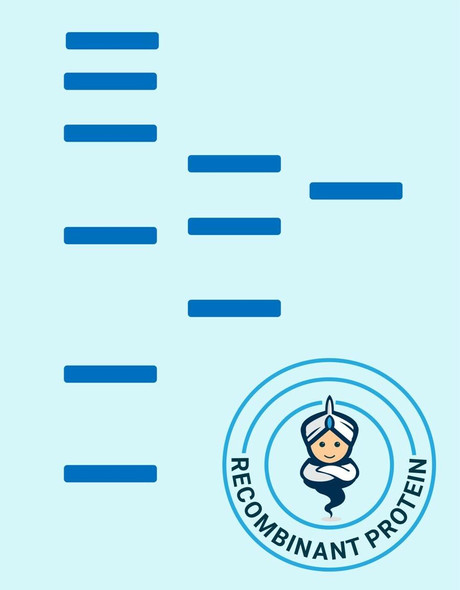CD Antigens Recombinant Proteins
Human sCD40L Recombinant Protein (RPPB0893)
- SKU:
- RPPB0893
- Product Type:
- Recombinant Protein
- Species:
- Human
- Uniprot:
- P29965
- Research Area:
- CD Antigens
Description
| Product Name: | Human sCD40L Recombinant Protein |
| Product Code: | RPPB0893 |
| Size: | 50µg |
| Species: | Human |
| Target: | sCD40L |
| Synonyms: | CD40-L, Tumor necrosis factor ligand superfamily member 5, TNF-related activation protein, TRAP, T cell antigen Gp39, CD154 antigen, sCD40, IGM, IMD3, HIGM1, T-BAM, TNFSF5, hCD40L. |
| Source: | Escherichia Coli |
| Physical Appearance: | Sterile Filtered White lyophilized (freeze-dried) powder. |
| Formulation: | Lyophilized from a 0.2�m filtered concentrated (1mg/ml) solution in PBS, pH 7.0. |
| Solubility: | It is recommended to reconstitute the lyophilized sCD40 in sterile 18M?-cm H2O not less than 100�g/ml, which can then be further diluted to other aqueous solutions. |
| Stability: | Lyophilized sCD40 although stable at room temperature for 3 weeks, should be stored desiccated below -18°C. Upon reconstitution CD154 should be stored at 4°C between 2-7 days and for future use below -18°C. For long term storage it is recommended to add a carrier protein (0.1% HSA or BSA).Please prevent freeze-thaw cycles. |
| Purity: | Greater than 97.0% as determined by:(a) Analysis by RP-HPLC.(b) Analysis by SDS-PAGE. |
| Biological Activity: | The ED50 as determined by the dose-dependant stimulation of IL-12 induction & IL-8 production by human PBMC was found to be 5-10 ng/ml. |
CD40L or CD154 is a membrane glycoprotein and differentiation antigen expressed on the surface of T-cells. The CD40 ligand stimulates B-cell proliferation and secretion of all immunoglobulin isotypes in the presence of cytokines . CD40 ligand has been shown to induce cytokine production and tumoricidal activity in peripheral blood monocytes. It also costimulates proliferation of activated T-cells and this is accompanied by the production of IFN-gamma , TNF-alpha , and IL2 .
sCD40 Human Recombinant produced in E.Coli is a non-glycosylated, Polypeptide chain containing 149 amino acids and having a molecular mass of 16308 Dalton. The sCD40 is purified by proprietary chromatographic techniques.
| UniProt Protein Function: | CD40LG: Mediates B-cell proliferation in the absence of co- stimulus as well as IgE production in the presence of IL-4. Involved in immunoglobulin class switching. Defects in CD40LG are the cause of X-linked immunodeficiency with hyper-IgM type 1 (HIGM1); also known as X-linked hyper IgM syndrome (XHIM). HIGM1 is an immunoglobulin isotype switch defect characterized by elevated concentrations of serum IgM and decreased amounts of all other isotypes. Affected males present at an early age (usually within the first year of life) recurrent bacterial and opportunistic infections, including Pneumocystis carinii pneumonia and intractable diarrhea due to cryptosporidium infection. Despite substitution treatment with intravenous immunoglobulin, the overall prognosis is rather poor, with a death rate of about 10% before adolescence. Belongs to the tumor necrosis factor family. |
| UniProt Protein Details: | Protein type:Membrane protein, integral; Cell adhesion Chromosomal Location of Human Ortholog: Xq26 Cellular Component: extracellular space; integral to plasma membrane; integral to membrane; plasma membrane; external side of plasma membrane Molecular Function:CD40 receptor binding; cytokine activity; tumor necrosis factor receptor binding Biological Process: B cell proliferation; platelet activation; regulation of immune response; leukocyte adhesion; positive regulation of interleukin-12 production; B cell differentiation; immunoglobulin secretion; isotype switching; inflammatory response; regulation of immunoglobulin secretion; negative regulation of apoptosis Disease: Immunodeficiency With Hyper-igm, Type 1 |
| NCBI Summary: | The protein encoded by this gene is expressed on the surface of T cells. It regulates B cell function by engaging CD40 on the B cell surface. A defect in this gene results in an inability to undergo immunoglobulin class switch and is associated with hyper-IgM syndrome. [provided by RefSeq, Jul 2008] |
| UniProt Code: | P29965 |
| NCBI GenInfo Identifier: | 231718 |
| NCBI Gene ID: | 959 |
| NCBI Accession: | P29965.1 |
| UniProt Related Accession: | P29965 |
| Molecular Weight: | 29,274 Da |
| NCBI Full Name: | CD40 ligand |
| NCBI Synonym Full Names: | CD40 ligand |
| NCBI Official Symbol: | CD40LG�� |
| NCBI Official Synonym Symbols: | IGM; IMD3; TRAP; gp39; CD154; CD40L; HIGM1; T-BAM; TNFSF5; hCD40L�� |
| NCBI Protein Information: | CD40 ligand; CD40-L; CD40 antigen ligand; T-cell antigen Gp39; T-B cell-activating molecule; TNF-related activation protein; tumor necrosis factor (ligand) superfamily member 5 |
| UniProt Protein Name: | CD40 ligand |
| UniProt Synonym Protein Names: | T-cell antigen Gp39; TNF-related activation protein; TRAP; Tumor necrosis factor ligand superfamily member 5; CD_antigen: CD154Cleaved into the following 2 chains:CD40 ligand, membrane form; CD40 ligand, soluble form |
| UniProt Gene Name: | CD40LG�� |
| UniProt Entry Name: | CD40L_HUMAN |






